Wow! This is all I feel I can say to properly describe our first cruise on the Gato Verde this past week. It was absolutely incredible. We left the labs Monday morning practically chomping at the bit to get to see the Gato for the first time after hearing and reading so much about it. When we finally got there, to my surprise, the boat seemed much bigger than I thought it would be, which trust me when living with the rest of my class is a good thing. All of our weirdness would not fit into a small boat.

The Gato Verde
After getting oriented to the boat we left and motored to Sucia island where we docked for the night. But as they say life’s not about the destination, its about the journey, which didn’t fail to stand true on the trip over. We all put our rain gear on and sat on the trampoline that stretched between the two hulls of the catamaran and were absolutely soaked by oncoming waves. It’s good to know that when REI tells you your pants are waterproof, they really mean it!

One of the challenging things about living on the boat is that we have to cook our own meals and plan our cooking ahead of time. I can definitely say that my cooking abilities have exponentially increased since they were pretty much limited to frozen foods and pasta, oh and I make a mean bowl of cereal. Although, you should know that I am a bit like a 5 year old in that I dislike almost all vegetables and cooking for vegetarians means I ate a lot of vegetables. I could practically hear the 5 year old inside me throwing a temper tantrum, but I was amazed upon finding that vegetables aren’t inherently evil, they’re actually rather yummy.
Now that my brain was properly fueled we learned about all of the science equipment we would be using and have available for our projects. Staying consistent with my shopping tendencies I was instantly fascinated by the CTD which measures conductivity, temperature, and depth, and happened to be worth roughly $50,000. Needless to say every time we deployed the CTD I had a miniature heart attack anticipating everything that could go wrong. After a day of collecting data on the CTD we realized that we weren’t actually recording any data. Robin finally realized that the ring around the start button was to protect the device during transit and was actually not a stylish accessory. We removed the ring and finally got successful data uploading from the CTD to the computer. After several deployments we got the hang of it and I am excited to start taking data for my project.
Today we worked on our service project that we are required to complete for the course. We decided to work with the San Juan County Land Bank and help with Garry Oak restoration on Cady Mountain. First we learned a little history about land use in the San Juans and the transformation the islands have seen since colonization. Then we took a trip to the Cady Mountain preserve to actually work hands on with Garry Oak restoration. We were able to help cut down trees to save trees… don’t think too hard about this it made my brain hurt. Actually, we were cutting down/ trimming other trees that were out-competing the oaks for sunlight. Don’t worry, we weren’t running through the forest willy nilly cutting down trees. We had a lot of fun helping to restore a beautiful area on the island while wielding really awesome ninja hand saws. I’m pretty sure it doesn’t get much better than that.
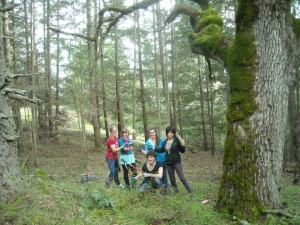
This week we are writing our proposals for our projects and will be finalizing them by Sunday before we head back out onto the Gato on Monday for our 1 week cruise of data collection. Hopefully the whales will be more cooperative and actually be in the San Juans while we are as well. Either way it is going to be an exciting adventure complete with sailing songs, random fits of laughter, and a lot of Sriracha.
Read More
Oh my Gato, what a week it has been! Monday began with an early wake up call and a hurried morning bustle in preparation for our first voyage on the Gato Verde! The six of us, Dana, Phinn, Taya, Breanna, Jamey and I stuffed ourselves into the Washington State Ford Explorer, only to drive five minutes to wait in line to board the ferry. While we waited, we decided to get coffee in a little cafe nearby. I really don’t like coffee, but I thought I would try a mocha milkshake considering that most milkshakes, regardless of the flavor, are delicious. It turned out to be a little too strong for my liking, but I drank most of it anyway. On the ferry, Phinn, Taya and I found a fruit themed jigsaw puzzle and started in on it right away. I’m not sure that I have ever felt so concentrated and determined in my life and I think it was the caffeine. We worked diligently on the jigsaw throughout our ride and we even had people betting on whether or not we would finish before we had to get off. We worked until the very last second we could, only to miss finishing it by about ten pieces. Do you have any idea how unsatisfying it is to miss finishing a puzzle by ten pieces? Needless to say, it was a very long ride to Bellingham as I stewed over the unfinished puzzle.
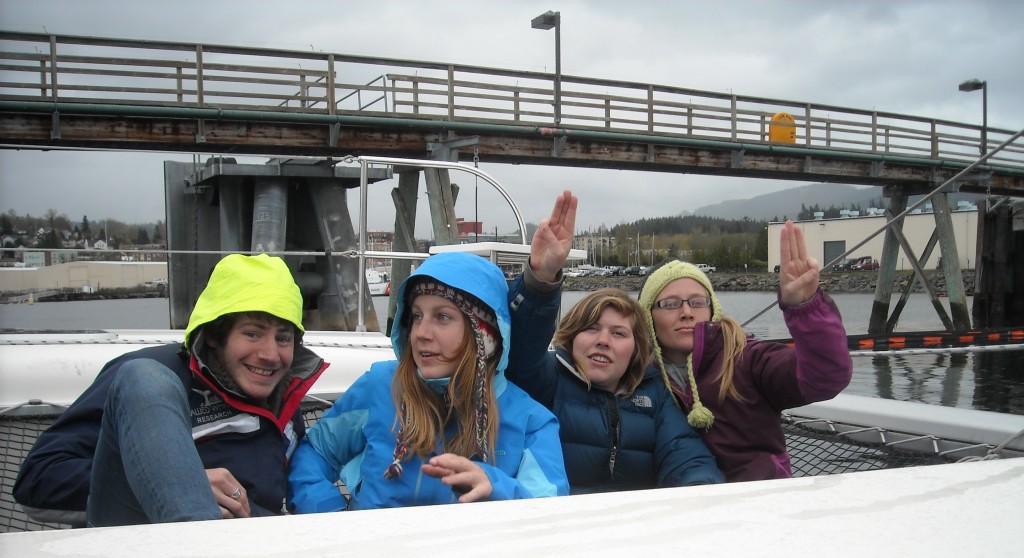
Phinn, Bre, Jamey and me hanging out on the trampoline before leaving Bellingham
When we arrived in Bellingham, we were welcomed aboard our new home on the water, the Gato Verde, by Captain Todd and had a brief orientation of the catamaran. The next couple of hours were spent loading the Gato with the plethora of science gear we brought with us and the many wonderful food ingredients we needed to make gourmet meals out at sea, including, but not limited to, milk chocolate, asparagus, white chocolate, eggplant, dark chocolate, loads of cheese, chocolate covered pretzles, tea, and chocolate brownie mix. By the end of our voyage, there was a pretty big dent in our food supply and not a hint of chocolate left. A short time later, last minute, final preparations were made and our four day journey began!
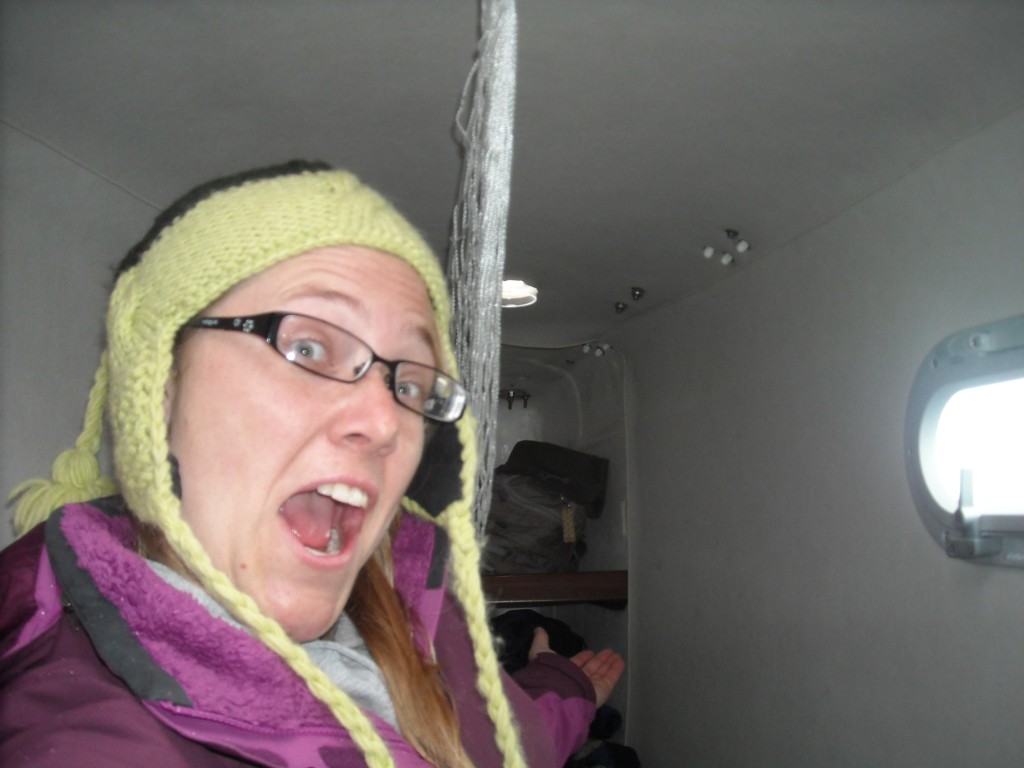
My berth
I had never spent an extended period of time on the water until this week and I loved every minute of it! The weather was decent and we spent the first afternoon on the front of the Gato, basking in the sun, being showered with waves on the trampolines. We docked for the night at Fossil Bay, on Sucia Island, and were welcomed by the most gorgeous sunset I have ever seen. I live in Tucson, Arizona, and nothing can compare to an Arizona sunset, but this was spectacular! Night fell fast and before I knew it, I was rocked to sleep by the gentle arms of the ocean, in my tiny little berth on the forward, starboard side of the Gato.
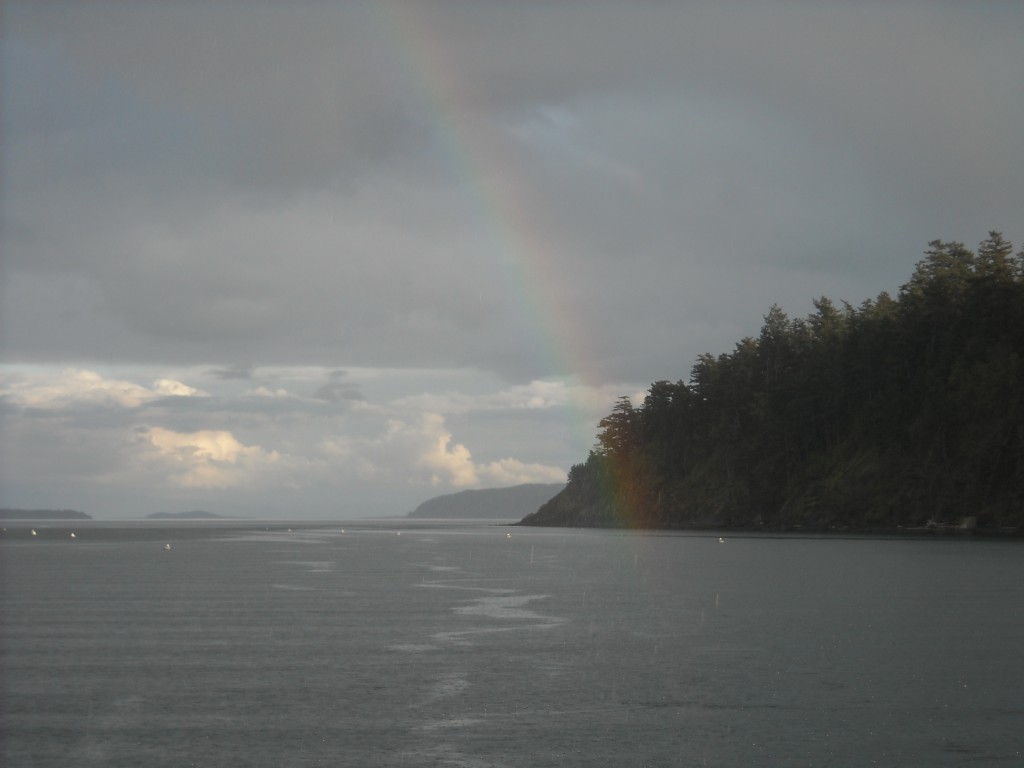
A view from the Gato at Fossil Bay, Sucia Island
The next few days out on the water, we learned how to deploy our scientific instruments, such as the CTD, to measure the conductivity, temperature, and depth of the water, a niskin bottle to collect water samples, a secchi disk to measure the water’s visibility and of course a hydrophone to get a feel for listening to the aquatic world beneath us. We traveled all over the Northern Inland waters and even floated into Canadian waters for about 20 seconds. It was my first time being in Canada and I was stoked! We also learned some of the fundamentals of sailing, like tacking, which was my favorite part of the trip! Sailing is so much fun! We had a good amount of down time during our adventure to relax on the Gato and explore the islands after we had docked for the night.
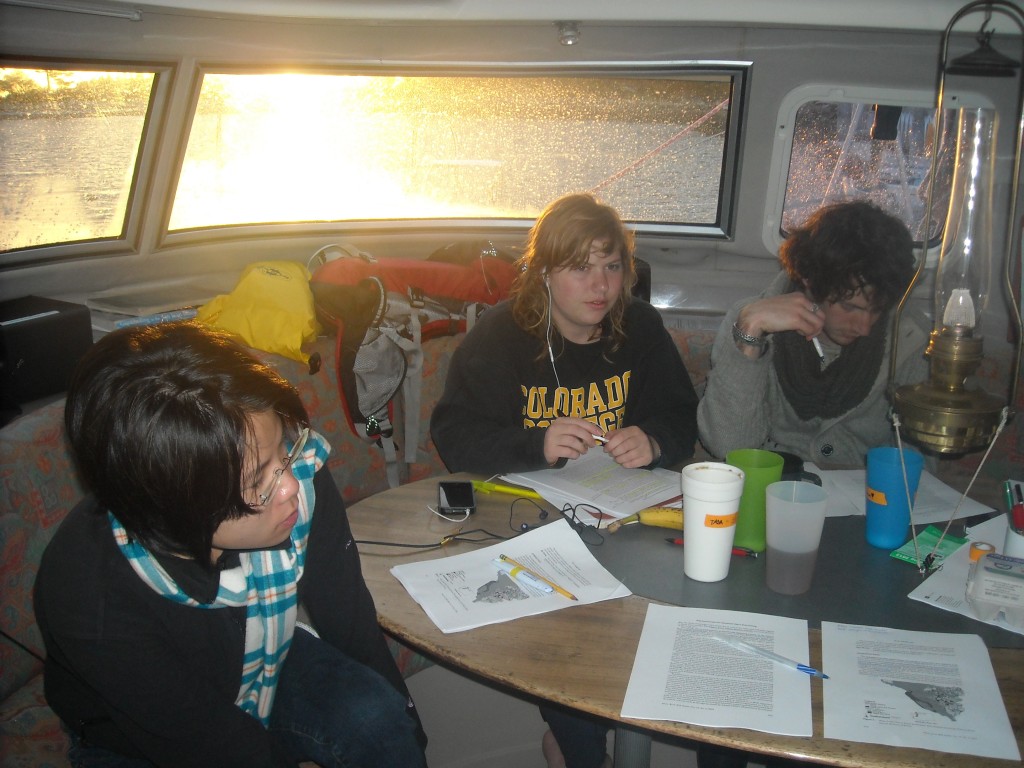
Taya, Jamey and Phinn working diligently
Our time sailing was full of great learning experiences. In the mornings after breakfast, our responsibilities included things like washing the decks and cleaning the heads (bathrooms) to rid the catamaran of mung, and fulfilling a systems report to monitor how much fuel, fresh water, and sewage storage we were using. We also had a navigator who listened for the weather report, observed tides and currents, and determined our course for the day. For this trip, I had a chance to clean the heads, do the systems report, and navigate. Each job was very different, but equally as important as the next.
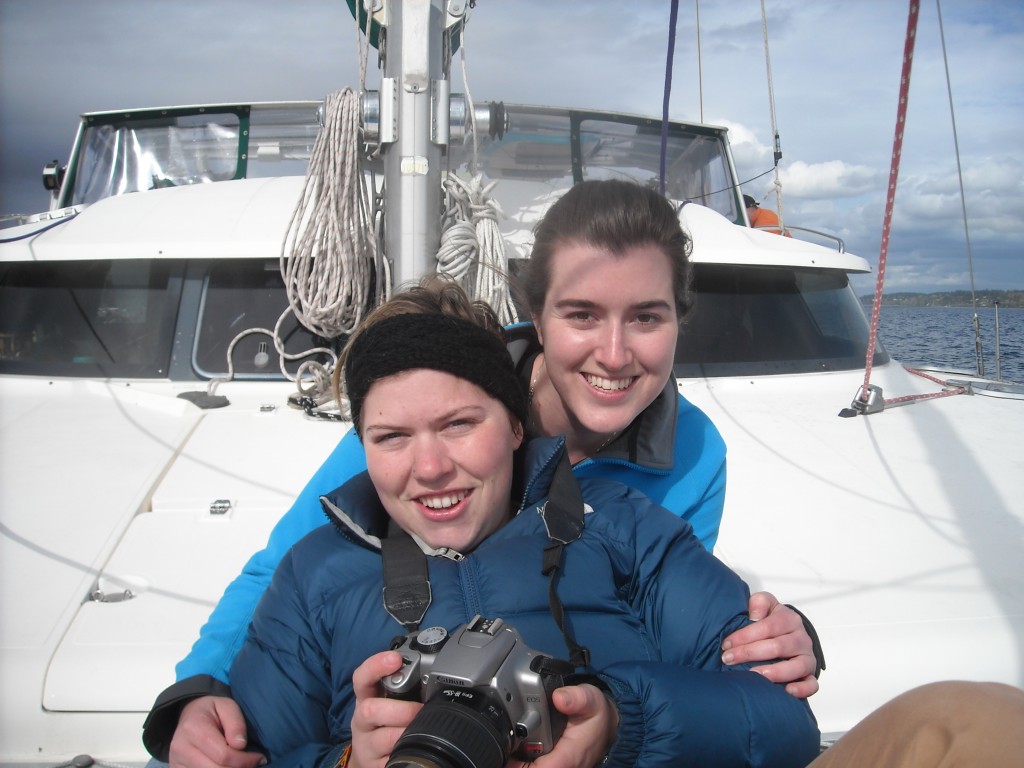
Jamey and Dana relaxing on the catwalk
Not only did I learn about science and my upcoming research on this voyage, but I also learned a great deal about the people with whom I am to share the Gato for our upcoming trips. I have gotten to know my new friends pretty well in the time that we have spent on land at the Friday Harbor labs, but being confined to a catamaran with them has allowed me to get to know them even better, especially when a common sailor theme song continuously resonates through our heads. As has been the theme of my time here on the island, things just keep getting better and I can’t wait for our next grand adventure!
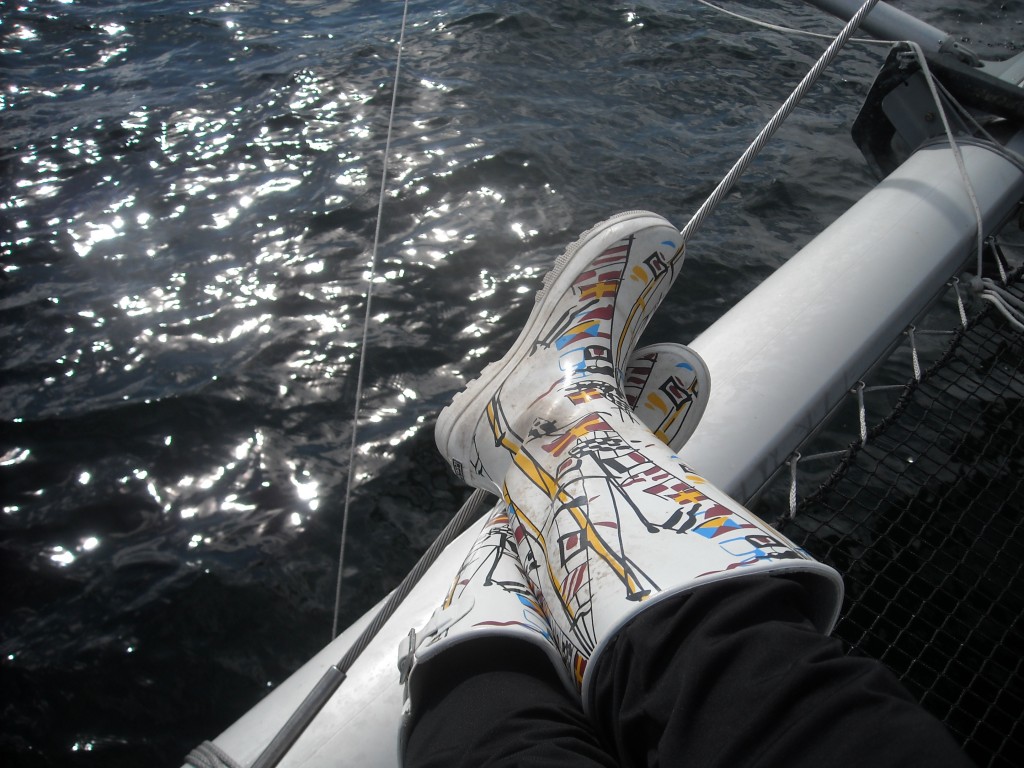
I love my life!
After an early start the group finally made it to Bellingham, WA where we met the Gato Verde, and Captain Todd, for the first time. Despite looking through past Beam Reach sailing photographs the “Gato†exceeded my expectations. When I was younger, I would always pester my dad to take me to the harbour to look out at the boats. This time, as I looked out onto the dock, a beautiful 42ft hybrid electric-biodiesel catamaran stared back at me. Our home for the next few weeks, the Gato stood out amongst the other vessels.  Never did I imagine that one day the ocean would be my classroom.
After having a brief tour of the boat—whilst it was safely fastened to the dock— we began exploring our cabins and bringing fancy science equipment on board. My cabin was particularly quirky because it was positioned at the front of the boat and was accessed by a floor hatch. Although it seemed small, on first appearance, there was more than enough space for me to sleep comfortably in addition to housing my luggage (yes, I still haven’t mastered packing lightly).  In fact, I felt fortunate that I had one of two single ‘rooms’. Another feature of the boat that I loved was the ‘trampoline’ that spread the breadth of the fore deck. Fortunately, as this was just a ‘practice cruise’, the group found many opportunities to lie on the netting overlooking the water. We were hoping to get some bowriding Dall’s porpoise, but, we had no such luck.
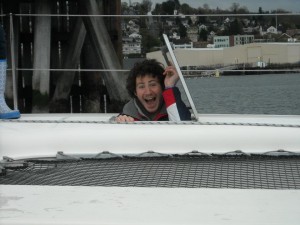
Peek-a-boo!
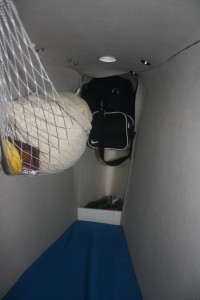
My cabin on the Gato
This particular four day excursion was intended as a way for us to adjust to life at sea. After a wobbly few hours we soon found our sea legs. Our mornings were structured around a chore schedule, and included tasks such as washing the decks, cleaning the heads, listening to the weather, and figuring out the tide tables. The person assigned ‘navigator for the day’ was required to propose a route to be followed.  Another person was appointed ‘science lead’, and was responsible for holding a morning meeting. Our morning meetings enabled us to devise science objectives for the day. Collectively, over the course of the trip, we were able to deploy a variety of science instruments. Such equipment included hydrophones; that allowed us to record ambient noise at Cherry Point (where a coal terminal has been proposed). In addition, we were able to measure for conductivity, temperature, and depth at several sites by deploying a CTD to varying depths. By doing this we were not only discovering the varying physical properties of sea water at different sites, but, also getting experience at handling heavy equipment on board a rocky boat. In addition to these experiments, we were also monitoring our own energy consumption. Daily, we kept records of our water consumption, sewage use, and amount of biodiesel remaining. These are all important factors to consider whilst sailing, especially when practicing sustainable science.
In addition to the science, and the log keeping, the group had a sailing lesson with Captain Todd. We learned the names of the various lines, in addition to having a crash course on wind. We each took turns at the helm where we attempted to tack. Tacking, or coming about, is a sailing manoeuvre where the bow of the vessel is turned through the ‘eye of the wind’. This is commonly done when the desired direction of travel is (nearly) into the wind. In order to tack on something of Gato’s size, it requires good team work and strong communication. I felt the group excelled at this.
Read More
This morning began as a usual Monday here at the labs. I rolled out of bed and stumbled to breakfast, half asleep and hungry as always. It was a gorgeous day, the sun was shining and it reflected off of the water in the harbor. After breakfast, I meandered back to S1, preparing my mind for the arduous, yet thoroughly interesting day ahead. The syllabus hinted that we would be diving in the realm of bioacoustics which I worried would be saturated with physics, a subject that most days just goes right over my head. Class began shortly, and it didn’t take long for those physics terms to start popping up. A few hours ticked past and it was nearing 11:00 am. We were diligently listening to Scott lecture on sound waves, when Robin made a sudden, dramatic exit from the room. She hurried out the door and disappeared, only to scurry back inside ten minutes later shouting, “There are orcas in Friday Harbor!” I have never seen eight people drop everything so fast. Laptops and notebooks were flying through the air as we ran excitedly out of S1 and down toward the harbor. It was as if our lives depended on seeing these whales. My heart was beating so fast, I hardly noticed the treacherous rocks we sprinted over to spot the whales. As we reached the edge of the island, what looked like four orcas could be seen swimming North out of Friday Harbor. Among the blows and the dives, I caught glimpses of a juvenile whale with the others. Words cannot express how utterly and deeply I was affected by my first sighting of these amazing creatures, the killer whales. They only took a short time to be out of our visual range, but they will forever be imprinted in my memories. What a grand day!
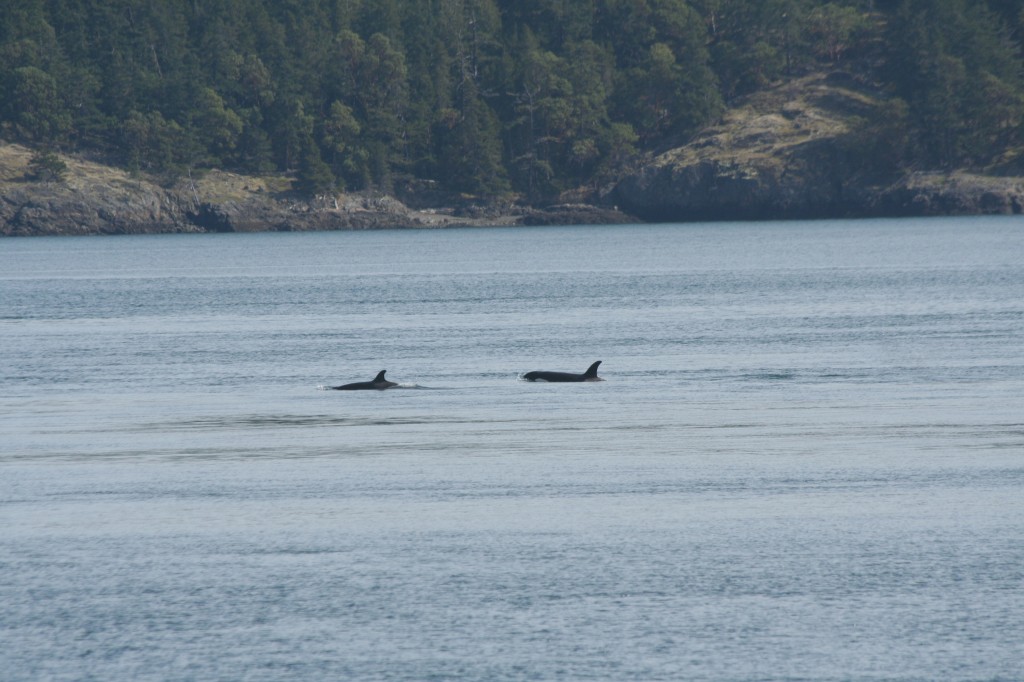
Orcas in Friday Harbor!!!!
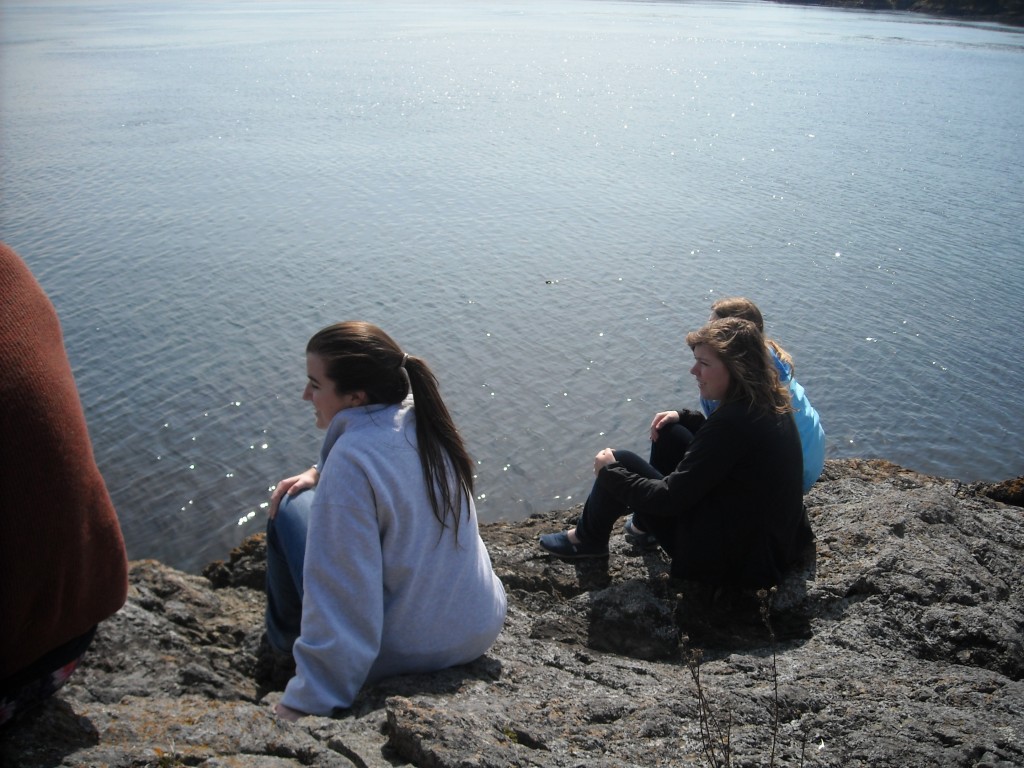
Watching the Whales
Read More
The Friday Harbor Labs have a number of trails to explore, that weave and wind through the woods behind the labs. Rachel, Taya, and I decided to go explore some these trails one afternoon. As we were walking down muddy trail we spied a small tunnel that appeared to lead through a thicket. After bushwhacking through the gnarled tunnel, which had more thorns than we had anticipated, we emerged onto a breathtakingly beautiful meadow that overlooked the ocean. This was no ordinary meadow, it was the kind of meadow that you go to on a sunny day to make daisy chains. The ground was covered in a thick layer of emerald green moss that gently hugged us as we sat on it. Below the blissful meadow lay a small beach covered in soft rounded pebbles that made a pleasant clacking sound as we walked over them. As the sun began to sink lower in the sky it started to dawn on us that we had to get back to the trail. We didn’t want to go through the tunnel because it was unpleasant enough the first time. We decided to head due west towards the trail. Our zigzagging path through the woods took us on an adventure full of thorns and laughter. Hopefully next time we go to our amazing spot in the woods we can find a better way to get there!
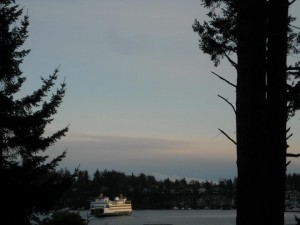
This past week in class we each read and discussed a paper on sustainable fisheries. I chose a case study that evaluated the environmental impact of different varieties of feeds used at salmon farms. The main goal of this study was to determine if organic salmon feed had less of an environmental impact than the conventional salmon feed. The study used four different types of salmon feed. The LCA methodology was used to evaluate the environmental impact of each feed. Each ingredient was assessed on its environmental impacts from cradle-to-grave. They found that the organic ingredients outperformed the conventional ingredients in every category except ecotoxicity. This article really helped me grasp just how big of an impact farmed fish have on the environment. A good way to further the study would be to test the health impacts of organic vs. conventional  feed on the salmon.
Link to Feeding Farmed Salmon: Is Organic Better?
http://www.fcrn.org.uk/sites/default/files/Feeding_farmed_salmon_-_is_organic_better.pdf
Read More
My case study for this week centered on reducing bycatch of juvenile red snappers by shrimp trawls in the Gulf of Mexico. The paper is: Designing marine reserves to reduce bycatch of mobile species: a case study using juvenile red snapper (Lutjanus campechanus), by Diamond et al.

Red snapper from the Gulf of Mexico
The research team made use of geographic information system (GIS) to map fishery-independent trawl surveys done by the Southeast Area Monitoring and Assessment Program (SEAMAP) every summer and fall in the Gulf of Mexico from 1987 to 1997.
The paper attempts to asses whether there is a geographic pattern to the distribution of juvenile red snappers.
Diamond et al. analyzed juvenile red snapper distribution and examined “hot spots†with high concentration (intensity) and the predictability for the hotspot to reoccur in the same position over time (persistence). In designing marine reserves, one could designate no-trawling zones according to the desired level of intensity and persistence which correspond to percent or numerical bycatch-reduction goals.
In further consideration, given that red snappers are highly mobile and higher-intensity hotspots are often unpredictable, a no-trawling zone does not need to be permanent. Ideally, such a no-trawling zone could be fluid from year to year, in order to avoid trawling in higher-intensity hotspots.
For a no-trawling zone to be fluid, it would depend on how effectively this information could be disseminated in a timely manner. This could also apply to marine vessel no-go zones in the activity range of Southern Resident Killer whales. In the San Juan community, dissemination of information should be relatively easy due to wide availability of communication technology.
Read More
It is amazing how quickly a strange place full of unfamiliar faces can begin to feel like home. This experience only continues to get better.
In class this past week we looked at ecosystems from the “bottom upâ€. In a brief description, this means that you study ecology from the bottom of the food chain up to the top, examining the ecological differences in tropic levels. Combining this newer topic while still emphasizing sustainability science, we discussed case studies that look at sustainable fisheries.
My case study was “An ecosystem based approach for Alaska groundfish fisheriesâ€. I found this particular paper to be especially interesting because it focuses on managing fisheries from the perspective of the ecosystem instead of focusing on the economic benefits. The Alaskan groundfish fisheries management is known for being progressive and fairly sustainable. The total annual catch has been at 2 million tones for the last 20 years, an impressive statistic. The National Pacific Fishery Management Council wanted to include all aspects into the management process including: public participation, scientific research, comprehensive monitoring, gear restrictions, habitat conservation areas, and more. Conservative catch limits are highly emphasized and the total annual catch is always less than what the environment can sustain. This is a cautionary approach to fisheries management. The two aspects of the management plan that was most impressed with were the Marine Protected Areas and the examination of Marine Mammals and Seabirds. The Marine Protected Areas allocate specific locations that are important to the ecosystem and ban fishing from these areas, or lower the catch limits. This approach also takes into consideration the fisheries impacts on marine mammals and seabirds. Lowering by-catch rates, and decreasing negative interactions between the animals and the fishing boats are two of the goals for this aspect of system. I found this “ecosystem†approach to fisheries to be interesting and insightful. One important thing that I took away from our discussion of this paper is that although the management reports appear to be purely positive, every system has its downfalls.
Fisheries are incredibly important to understand right now in the world of killer whale
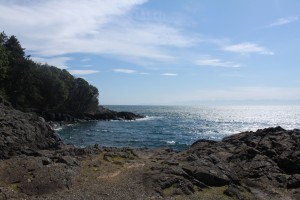
Perfection
conservation. We know that a lack of prey, specifically Chinook salmon, can have a huge impact on the population dynamics of the Southern Resident killer whales. Discussing a variety of fisheries management systems helped me have a better understanding of the current debates about salmon abundance and health here in the Pacific Northwest.
Yesterday we were lucky enough to have beautiful weather again. We spent our day off adventuring to Lime Kiln lighthouse and found a wonderful view atop the kiln itself. I never know what to expect here, this place has a way of surprising you all the time, but I am loving every minute of this adventure.
Read More
Fortunately we have been able to spend a large proportion of our time this week outside basking in the Washington sunshine. Although thunderstorms were predicted at the beginning of the week, the forecasts seem like a distant memory. Many hours have been spent this week staring out across Haro Strait in search of the ever elusive whales. We know that they are out there because we can hear them on the hydrophones. A few fortunate folk have even caught glimpses of them as they have passed by nearby inlets (not us).  Throughout the San Juans, there is a network of researchers, whale watching boats, and whale heads who keep tabs on the whales and there whereabouts. It is only going to be a matter of time before we see them for ourselves (I can feel it).  Today, there were sporadic reports of transients throughout the Strait, and so a few of us decided to try and hitch a ride across the island to Lime Kiln. Hitch hiking is apparently a popular and efficient way to get around the island. In fact, there are designated pick up areas specifically for hitch hikers. It did not take long before the first vehicle stopped for us. On arrival to Lime Kiln we were greeted by an influx of tourists who were making the most of their Easter Weekend. Sadly no whales.  We did however spot one river otter foraging in the shallows. We were later joined by other students from FHL (mostly the Zoobot crowd). As we imparted our whale knowledge with the Zoobots, they in turn shared facts about various intertidal invertebrates. Such an interesting crowd!
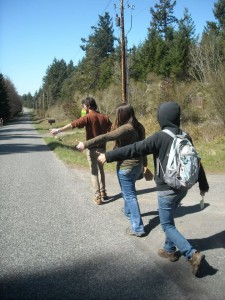
Hitchhikers Guide to San Juan
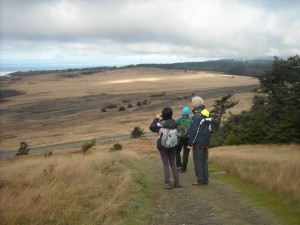
Taking in the view
We also explored numerous locations on the south side of the island including Cattle Pass, and South Beach. Cattle Pass is a really unique site where the shallow sea floor forces great quantities of water through a small channel. Thus, the area experiences strong currents which attract an array of sea birds and marine mammals. We were able to test out our birding skills from land-based observations (we still need a bit of work on identifying certain species). Another great reason for visiting Cattle Pass was that it was referenced in one of the papers we were required to read for this week. In addition, to get better views (180 degrees) of the surrounding area, we hiked up Mount Finlayson. This got me thinking about how great of a vantage point the hill would be for viewing whales as they swam by. Â On the evening, we returned to the south side of the island to have a bonfire with some friends. The full moon cast its beautiful hues over the beach and out across the water. Splendid evening!
On the academic front, we were given the opportunity to present on a paper that identified bottom-up effects. At a basic level, ‘bottom-up effects’ refers to how the population density of a resource affects the population density of that resources’ consumer. Although most people chose to present on marine-related issues, I wanted to focus on a terrestrial case study. My paper was titled ‘Bottom-Up Effects on Persistence of a Specialist Predator: Ant Invasions & Horned Lizards’. This paper discussed in detail the effects of invasive species on native populations. In my selected case study, a population of coastal horned lizards was being impacted by the introduction of the Argentinean ants to the area. These ants were destroying and out competing the ‘normal’ food source of the lizard. The lizards are ‘sit and wait predators’, and have highly specialized diets. Because of this, they cannot, or are unwilling, to switch to an alternative food source. On reading this, I couldn’t help but notice the similarities between the horned lizards and the SRKW who depend on one species of salmon, the Chinook, despite the abundance of other species in the area. A second paper I discussed this week was titled ‘Management Effectiveness of the World’s Marine Fisheries’. This paper sought to evaluate how management affects fishery sustainability. I was particularly interested to read how sustainability was defined, and also how it was measured. The blend of science and policy made for a good paper. On the topic of good papers, Andrea Buckman and Cara Lachmuth (DFO Scientists) came in to present on their past research. Cara’s presentation on ‘Killer Whale Exposure to Engine Exhausts’ raised some interesting questions, highlighted gaps in existing data, and drew attention to potential areas of future study. The two guest lecturers also sat in on our weekly mentor meetings, offering advice and giving examples of how we can expand on our final research projects. This was greatly appreciated!
Read More
So this week we were able to observe a harbor seal necropsy which is essentially a dissection but since we’re biologists we gave it a fun name. Once I got past the smell and the obvious fact that they were cutting open a baby seal it was fascinating. If you have a particular fascination with all things grotesque you can check out Rachel’s blog for a picture. Its pretty cool I’d check it out. While nothing could really compete with getting an inside look at a harbor seal it’s been a pretty good week. We’re preparing for our data collection at the Lime Kiln lighthouse and starting to narrow down our ideas for research projects, which is much harder than I initially though it would be, there’s just so much to ask. We also travelled to Mount Finlayson which was a bit of a hike, but totally worth it as it gave us a great view of cattle pass and the surrounding waters at the southern tip of San Juan Island.
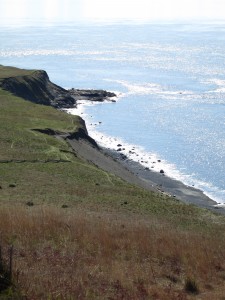
In the meantime we’ve been continuing our work in the classroom and combining our interests and the class theme of sustainability. We were responsible for finding another case study but this time about sustainable fishery practices which was right up my alley, being a fisheries major and all. So I looked at a paper titled Estimating mortality of Atlantic bluefin tuna in an experimental catch-and-release fishery. I think its a requirement that all research papers have an excessively long title. The paper looked at the potential to create a catch-and-release fishery to limit fish mortality. Studies have been done on why people fish and the most often reason is the social bonding experience. Often times its a family tradition passed down from generation to generation, so this way people can still have that experience while conserving the tuna population. The study sought to simulate the proposed regulations of the fishery to get results that would resemble what might happen on the boat. The researchers caught 60 fish and managed to tag 59 of them with PATs which are pop-up archival tags. These tags include microchips with a sensor, transmitter and float. They can measure temperature and depth and are preprogrammed to release from the fish and float to the surface after a certain amount of time or death of the fish. The results show that only 2 fish died, and 4 tags didn’t successfully transmit. The rest of the fish survived except for one. If you noticed earlier I said they caught 60 and tagged 59. So that one was killed during the fight after the fish was hooked. There was an overall mortality rate of  5.1% which is much better than 100% if I do say so myself. I think this is a terrific idea, but much needs to be done before it will be successful. I would love to see them do another study with a greater sampling range of at least over 100 animals to get more accurate results. This type of fishing would also take strong leadership on the boat and experienced anglers. However I love that people are trying to find ways to combine human and environmental interests so that we can enjoy the things we do now for a long time to come.
Read More
Class began today on somewhat of a different note than usual. We observed a necropsy of a harbor seal, performed by veterinarian Joe Gaydos, which was thoroughly fascinating! The newly weaned, stranded male seal was rescued on a beach and was found with an injury just above its nose, which we later discovered had penetrated through the bone. The young seal was blind in both eyes, and it was speculated that the injuries had resulted in an attack from another harbor seal. It was determined that the extent of its injuries would not allow it to thrive in the open ocean if it was returned, so instead it was euthanized, as this was the fairest option. As unfortunate as it may have been for that poor little seal, it was extremely educational and beneficial for us to have been able to witness its necropsy.
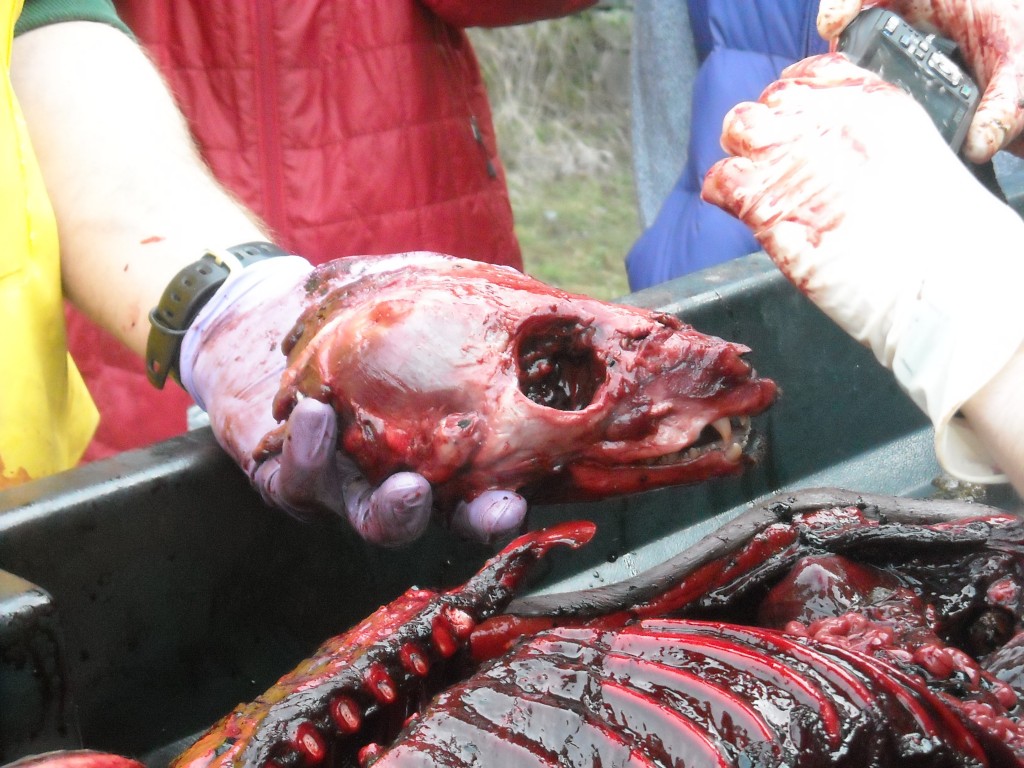
Harbor Seal Skull
Throughout the dissection, there was a great deal of education occurring that snagged at my light physiology background. It was fascinating to see each internal part of the seal accompanied by a brief explanation of what role it played in a living animal. I took an unholy amount of photos, as my interest in possibly becoming a marine mammal veterinarian was weighing heavily on my mind throughout the necropsy. I was bummed that we were unable to stay for the next necropsy candidate, a river otter, but I am so enthused about being able to have such an awesome experience!
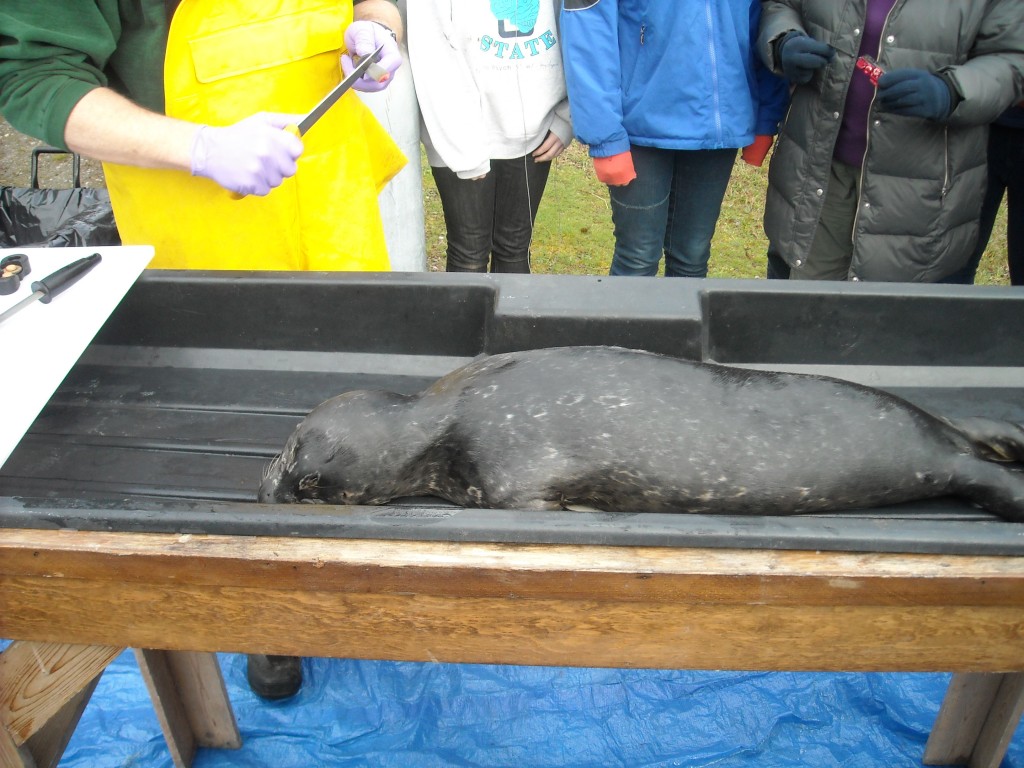
Just Before the Necropsy
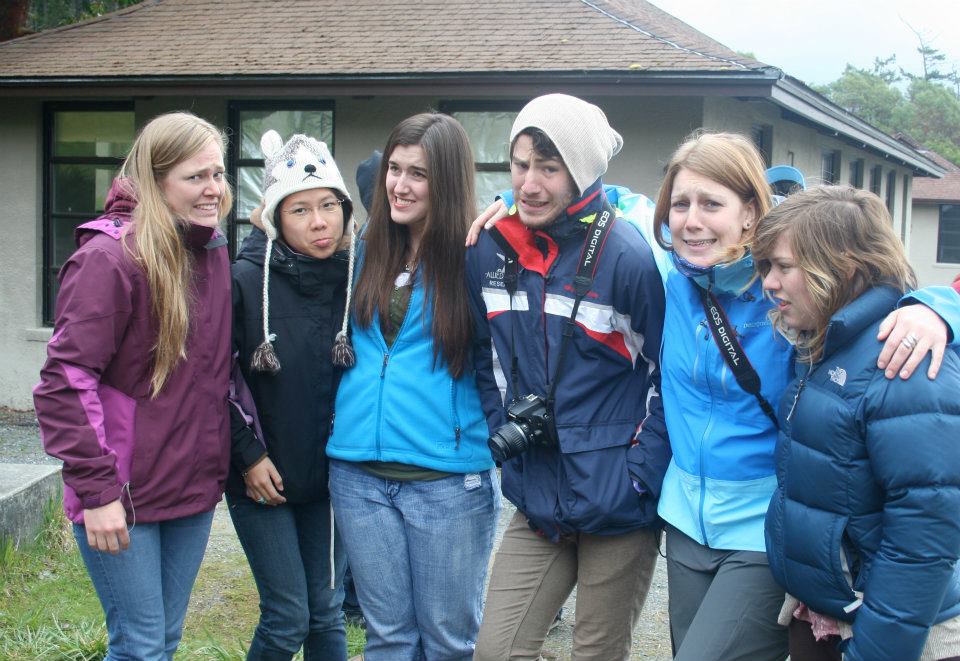
We Survived the Necropsy

























 Twitter
Twitter LinkedIn
LinkedIn Facebook
Facebook